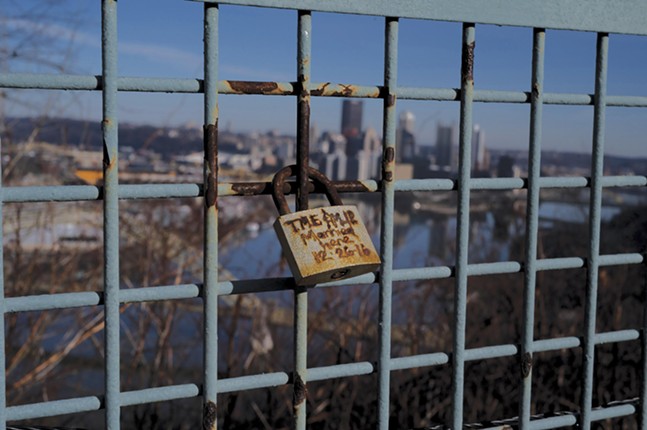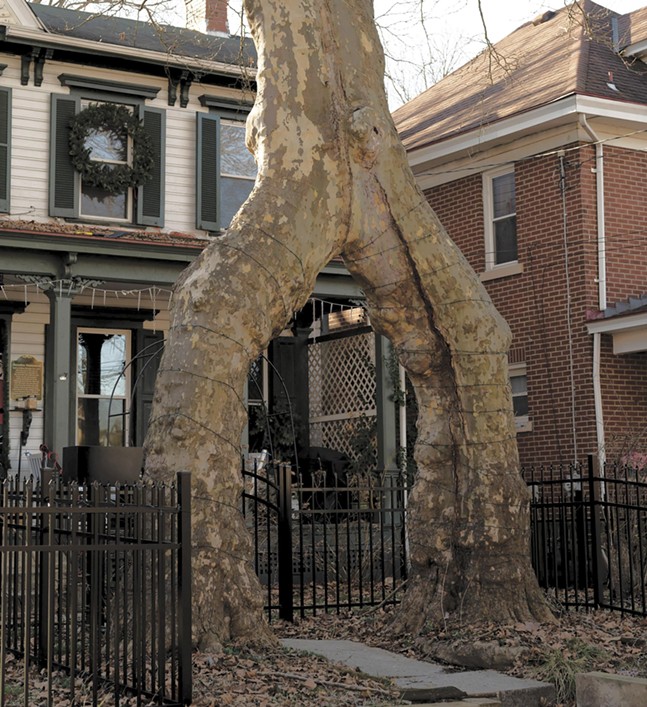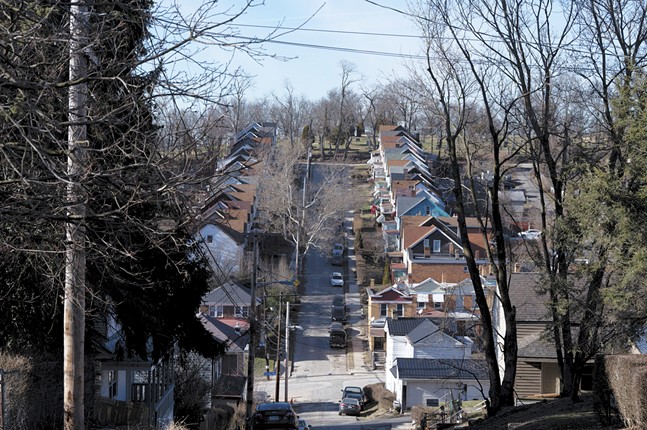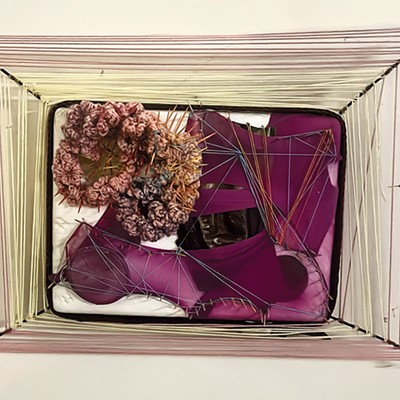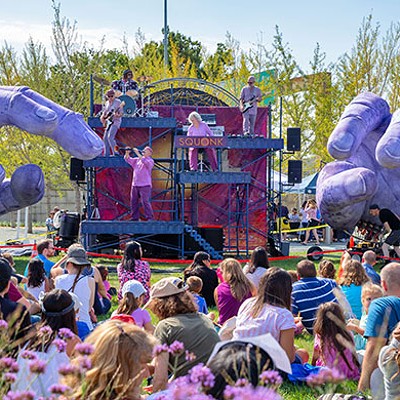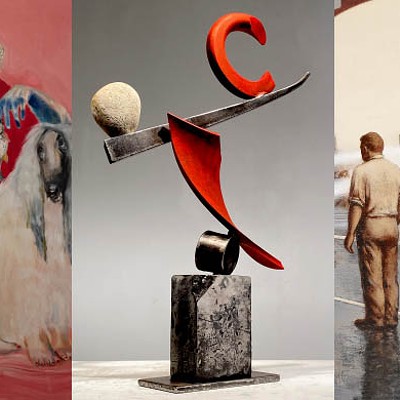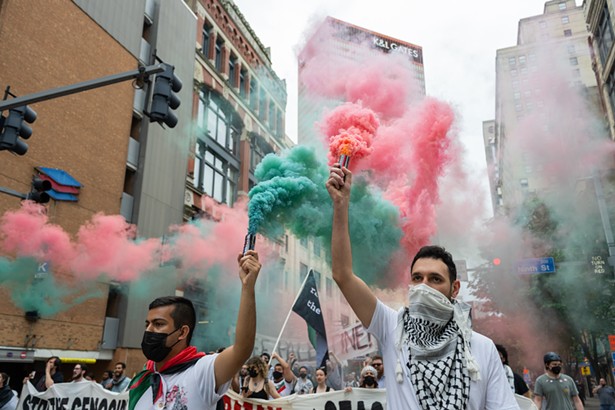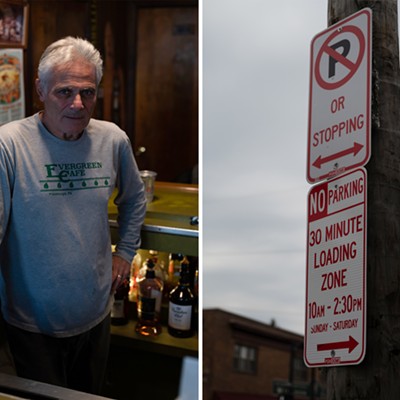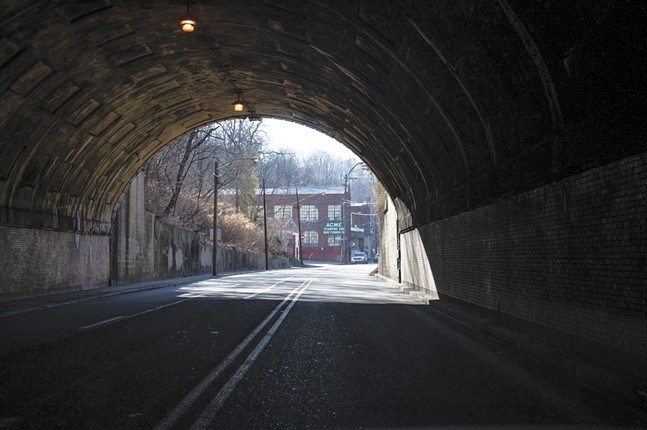
There was little to do in the neighborhood, but the efficient West Busway was right there, and I discovered the engineering marvel that is our public steps. I spent what free time I had between shifts of selling museum tickets and frying wings walking up and down Sheraden's zigzagging streets and taking the busway to the Duquesne Incline to visit friends on Mt. Washington. It was an unsteady, anxious time in my life, but moments, including rare solo trips up the incline, gave me a huge crush on Pittsburgh that persists to this day.
Still, coming back home alone on the G2 — even after I got my cat — always felt a little sad. Sheraden had curving streets with cute storefronts. I lived in Germany for a time, and Chartiers Ave. reminded me of German suburbs. Langley School, a grand gothic edifice, was flanked by charming churches and houses.
Yet, then as now, many of the storefronts were vacant or had been hastily turned into housing. Trash clogged the pocket parks. The only watering hole was a nearby VFW.
Long after moving to the East End, I make occasional trips back west to see what's changed. The Village Tavern (amazing pizza) closed; a couple of Family Dollars opened; some condemned buildings are now rocky lots. I've got a soft spot for the area. The housing stock is amazing, the people kind. But there's a wariness to the West End, a sense of having been left behind by the rest of Pittsburgh, that seems to play out in the area's economics and public safety.
Why?
Part of the West End's isolation is physical. A massive railroad berm hides the West End Village from commuters driving on the neighborhood's titular bridge, and drivers get just a fleeting glimpse before the road shunts them past onto I-376 and Sawmill Run Blvd.
The creek that gave the boulevard its name still flows through the area and out a culvert into the Ohio River. Its banks initially hosted Indigenous tribes, then trappers and traders from France, England, and elsewhere, then early settlers who built mills and small factories along its edge all the way up to the muddy Ohio riverbanks. Sometime around the end of the American Revolution, a stone tavern was built, though the settlement that blossomed nearby ironically ended up taking the name Temperanceville.
Pittsburgh absorbed Temperanceville in 1874 and had gobbled up neighboring Chartiers City, Crafton Heights, East Carnegie, Elliott, Esplen, Oakwood, Sheraden, and Westwood by the mid-1920s. The city later annexed Banksville, Ridgemont, and some outstanding parcels in what's now Windgap and Fairywood.
Annexation meant interconnection, with the area's numerous dirt toll tracks giving way first to plank roads, then streetcars and paved highways. The Pennsylvania Railroad dumped tons of earth on what had been a slum at the mouth of Sawmill Run to create a viaduct that was then perforated by the West End Circle, which directed traffic through the area and onto the West End Bridge.
"The West End was a beautiful valley that opened up to the Ohio River until the Pennsylvania Railroad boxed it in," Norene Beatty, a longtime area resident and self-described "history buff," tells Pittsburgh City Paper. Then came the automobile.
"[U.S. Routes] 22 and 30 went straight through the heart of the West End, and when they built the Parkway West and the parkway extension … They tore down all those houses that were on the backside of Duquesne Heights, or Coal Hill," she says, calling the parkway the neighborhood's "kiss of death."
"The roads have literally cut the West End off from the city," Beatty says.
(City Paper initially reached out to Beatty to discuss the Old Stone Tavern, but the building's current owners are still at work on plans for renovation, and both they and Beatty declined to comment on the tavern specifically.)
Beatty settled in Elliott in 1959 and remembers a neighborhood replete with grocers, butchers, bakers, several five-and-dimes, a theater, and various restaurants and bars ("one tavern after the next," she tells CP). The area population was served by numerous schools, worshipped in numerous local churches, and had access to the third Carnegie Library that the steel magnate built in the region in 1899.
However, car-centric shopping centers on Noblestown Rd. and over the hill in Crafton drew local consumers away. "There were all types of businesses, while everybody got in their car and went to the [Crafton-Ingram] shopping center," Beatty laments, "and, one by one, those businesses, they had no more customers."
Compounding this was racial unrest. The Great Migration fueled white flight to the suburbs; luminaries such as Martin Luther King, Jr. were assassinated, and Pittsburgh endured spasms of violence and white resistance to school busing as the area bled population.
I went out to Obey House Tavern while finishing up reporting for this story. The tavern is one of the few watering holes still serving drinks and pub grub in the West End. Their beer's cheap and cold, and tacos are two dollars apiece on a Wednesday, so I order four.
"Elliott used to have all kinds of stuff," the bartender tells me. "There used to be five bars, a pharmacy, a grocery store." She now lives in Sheraden and says she's watched the West End spiral. In particular, she says absentee landlords and a proliferation of Section 8 housing has led to property neglect — Beatty likewise highlighted during our interview that "bring[ing] back homeownership" in the area would foster a greater sense of pride and community cohesion.
The bartender confirms the decline with a patron.
"Neighborhood's gone to shit," he says matter-of-factly.
I finish my tacos and walk back out to the dark parking lot. Lights twinkle from houses on the steep hillsides, and it's a quick drive back over the bridge home.
"We are called the 'forgotten community,'" Terri Minor-Spencer tells me when I reach her by phone during a day of Zoom calls. "You did know that, right?"
I did — it's something Beatty and others had corroborated. Minor-Spencer is the founder of West End Providing Opportunities with Effective Resources (POWER) and is adept at seeing the buds among the jagger-bushes. Having spent 16 years incarcerated, she eschews the term "inmate" as a slur (instead, some people have "colorful backgrounds"), and she fiercely defends the community members she's helped rebuild their lives after time in the justice system, including the 38 and counting graduates from West End POWER's career readiness program.
Minor-Spencer says part of the area's ongoing issue with violence stems from youth feeling hopeless. "When you walk outside of your home every day, and you're eight or nine or 10 years old, and all you see is trash … that is going to do something to your spirit, period."
She deplores the West End's longstanding lack of community centers, as well. "You don't even have a place … to even sit down and read a book with someone else besides the library," she says.
POWER has been ramping up services accordingly. Last year, the nonprofit partnered with Pitt researchers on a youth violence prevention project. West End POWER has also established a hydroponic "freight farm," printed affirmational yard signs, encouraged residents to get reinvested in local politics, guided the formerly incarcerated through anger management courses, and helped numerous West Enders improve their resumes and learn the "soft skills" needed for a shifting job market.
It's a team effort. Minor-Spencer highlights numerous others doing work in the area, including Christy Porter and her husband Joey, a former Steeler. The pair opened the Jasmine Nyree Campus serving youth and adults with autism two years ago in Sheraden, though it was recently damaged in a fire.
Pittsburgh City Councilmember Theresa Kail-Smith says the Porters are "doing some extremely important work not just for Pittsburgh, but for the state."
Kail-Smith has represented District 2, which encompasses all or part of 24 neighborhoods, including the entirety of the loosely defined West End, since 2010. She likewise says the Nyree Center, the Salvation Army in Fairywood, Save a Life Today (SALT) Pittsburgh, as well as other community organizations and institutions help hold the community together in the face of change.
"We're home to Pittsburgh Musical Theater in the West End, which has performances at the Benedum and the Cultural District downtown," she tells CP. "They also have performances here at the Gargaro Theater." There's also the James Gallery, the Karpeles Manuscript Library Museum, several of the city's best public pools, and, of course, the West End Overlook. Kail-Smith also teases plans for new businesses in the West End Village.
Meanwhile, Kail-Smith says new families are finding forever homes close to where she lives. "Westwood has grown tremendously in terms of the LGBT community," she says. "We have a very diverse community here. We have a lot of immigrants here. We have a lot of renters, a lot of homeowners."
She's also optimistic about investment in a variety of projects. Sheraden Park has seen stream daylighting and other improvements. The West End Bridge is slated for upgrades including state-funded restoration and easier pedestrian and bike access.
"I wish I could take people on tours of our district so they can see it because I think they have a misunderstanding of what this area really is," Kail-Smith tells CP.
As for what her constituents want most? "Stability," she says.
Beatty hopes learning the area's history will foster deeper civic engagement. "A lot of the history of Pittsburgh began in the West End," she explains. "I just think there is so much of Pittsburgh's history that Pittsburghers don't know and should know."
"It's a hidden gem because it's so close to everything," Beatty says.
"From the airport, we're 20 minutes. From Downtown, we're 20 minutes. Like, we're 20 minutes from everything. And so that's the good," Minor-Spencer says. What she wants now is more local, sustainable businesses such as Farmer Girl Eb, a Black-owned, farm-to-table grocer in a cute storefront at the West End Village's edge. Minor-Spencer says the East End Food Co-op offers a model worth emulating, and she's hoping for something akin to that where the wealth stays in the community — plus, ideally, a bank.
"Any neighborhood that's without a grocery store, without a bank, is not a thriving community," she says. "I picture my grandson, who's four today — I hope by the time he's 10, 15, that he's able to go to a grocery store and not have five Family Dollars within a two-mile radius."
"We need a safe place where we can build trust amongst each other," she adds.
